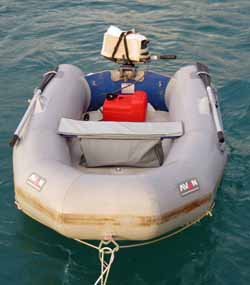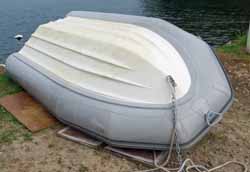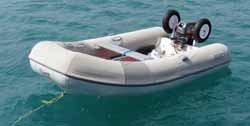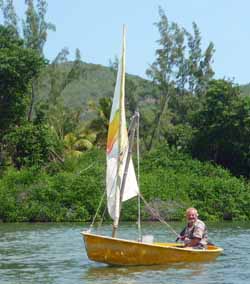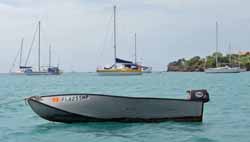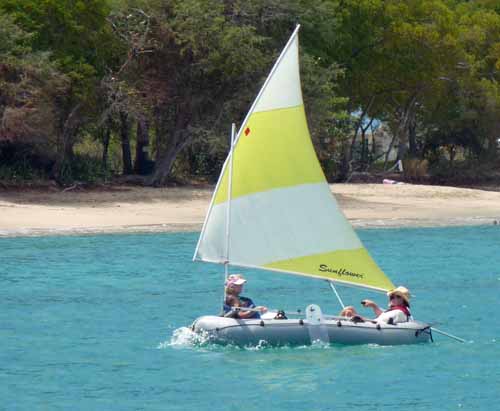- Home
- Choosing Accessories
- Inflatable Yacht Tender
Is an Inflatable Yacht Tender the Best Choice for Cruising Sailors?
Whilst an inflatable yacht tender is certainly the most popular choice with cruising sailors, there are a number of alternative options that should be given at least a passing consideration before rushing out and buying a new dink.
And even if you can't be dissuaded from taking the inflatable yacht tender route, there are plenty of things to think about before making your final choice.
Size is probably the first one that comes to mind, closely followed by weight - the two are obviously related - but what about fabric material, rigid hull or soft bottom?
And how about a sailing version, rigged with a mast and mainsail?
For most of us, cost will come into the equation somewhere, but for cruising sailors everywhere, the dinghy - inflatable or otherwise - will be your workhorse; it's got to be tough and durable.
Your Options...
But whatever your preference is, one of the first things you'll have to think about is what to do with it on passage...
Where to Stow Your Inflatable Yacht Tender
Your stowage options are:
- Stow it below deck;
- Stow it on deck;
- Hang it in davits on the stern;
- Tow it astern.
It's only when you start looking at these options, your choice of the compromise dinghy - for that's what it will be for all but owners of large yachts - will become apparent.
Stow it below: The best solution, but only really an option for 'roll-up' inflatables or collapsible rigid dinghies unless your yacht is large enough to sport a transom garage.
Stow it on deck: On most yachts there's room to lash to lash a tender upside-down on the foredeck. On larger yachts a better location is aft of the mast on the coachroof.
Either way, your vision ahead will be restricted and on an offshore passage where a boarding sea is always a possibility, the security of any such arrangement may be tested severely.
Permanently installed chocks and appropriately positioned strong-points to lash down to are a must.
Hang it in davits: Definitely the least hassle solution, and fine for coastal hops. But for an offshore passage it would be not without some risk.
Tow it astern: With the outboard motor removed rigid dinghies tow well. RIBs (Rigid Inflatable Boats) do too, but with a lot more resistance. Again, towing is fine for coastal hops in good conditions, but is clearly an unsuitable approach for an offshore passage.
The light weight of non-rib 'roll-up' inflatables enables them to fly like a kite when towed astern in a strong wind. Huge fun for onlookers, but not quite so entertaining for the crew. It's something that happens to most of us early in our sailing careers - and just the once.
A Rigid or an Inflatable Yacht Tender?
Whether it's an inflatable 'roll-up' yacht tender, a RIB or a rigid dinghy, one thing's for certain - it will get some abuse.
It will be dragged up stony beaches; left to bounce around with its mates on the dinghy dock; chafe against harbour walls and spend most of its life in the harsh sunlight.
Durability is a key requirement.
A 'Roll-Up' Inflatable Yacht Tender
These come with either slatted plywood (or fibreglass) floors, or separate inflatable floors, and - as their name suggests - can be deflated, rolled up and slipped into a bag complete with the two-piece oars and seat. Other types have two piece plywood floors which have to be removed before you can roll it up.
This one's our inflatable-floor Avon Rover, looking a little tatty these days without it's rubbing strip. I got tired of gluing it back on so now we manage without it.
Note the seat cushion/storage bag. A new acquisition with proves very useful for storing shore shoes, fins and snorkels, dinghy pump...
These are stable craft and have good load carrying ability, but the cheapest versions are so lacking in durability that they're not worth considering.
Inflatable yacht tenders constructed of PVC fabric will suffer from ultra-violet degradation, particularly so in the tropics - even if the tubes are fitted with a protective canvas cover they'll do well to last more than a couple of seasons.
In hot climates the harsh sunlight will destroy all but those made from UV resistant Hypalon polyester reinforced fabric or equivalent.
Most types have a wooden transom to take an outboard motor, but the simplest versions have an all-round inflatable tube. If you want to fit an outboard to these, you'll need a special bracket.
Compared to rigid dinghies, inflatables don't row very well at all, but those with inflatable keels have much better directional stability than the flat bottomed variety. With a sufficiently powerful outboard these keeled types will plane, which is more fuel-efficient than chugging along in displacement mode.
The inflatable keel is held in position by a floor which will be either of interlocking ply panels (heavy, and awkward to stow), plywood slats (which will conveniently roll up with the dinghy) or a removable inflatable floor.
My choice for Alacazam is the latter (see pic above); it's the lightest solution and adds rigidity to the dinghy. A 3m version equipped with a 5hp engine can easily be carried up the beach by two adults - an important feature in my book.
All Roll-up inflatable yacht tenders have a notable ability to slop water over the tubes when under way, often in sufficient quantity to dampen anyone's spirits.
A RIB (Rigid Inflatable Boat)
Or should that be RHIB, A Rigid Hulled Inflatable Boat? Either way, along with their higher price, it's the rigid hull that distinguishes these from their purely inflatable cousins. Heavier, but more stable than an inflatable, these can quickly be brought onto the plane by a suitably sized outboard.
A big plus is that the hydro-dynamically efficient hulls of an inflatable RIB throw the water aside, away from the tubes. Now you have a sporting chance of delivering your dear beloved ashore in a similarly pristine condition to that in which she set out.
These are particularly well suited for snorkelling or scuba diving excursions away from the yacht, where their high stability allows a reasonably fit and agile diver to clamber back aboard unassisted. The rest of us though may need a short rope ladder.
The hull material is either GRP or aluminium. My preference would be for one of the aluminium models, which are considerably lighter than their GRP counterparts, and more resistant to damage when dragged over a rocky beach.
For stowing on deck, an inflatable RIB can have its tubes deflated and tucked inside its hull, making it much less cumbersome and offering less resistance to a boarding sea.
It's when beaching a RIB, particularly a largish one with a heavy outboard, that a problem may arise - its weight.
With just a couple of people it will be impossible to haul it up the beach.
However there is a way around it as shown here. Fit a pair of drop-down wheels to the transom and hauling it up the beach is a piece of cake!
A Rigid Dinghy
For robustness, you can't beat a rigid dinghy. Made of wood, GRP or aluminium, they're less expensive than a similarly sized inflatable. Kits are commercially available for those who wish to build their own, usually in either marine ply or cedar strip.
Positive buoyancy is achieved either by building in airtight flotation chambers in the bow and stern seats, or by using expanded polyurethane foam between the outer hull and an inner skin.
The latter approach adds strength, but more weight. And if you damage the hull and saturate the foam, a lot more weight.
Rigid dinghies aren't as stable as inflatables so won't appeal as much to snorkelers or scuba divers who have to clamber back in over the side, although stability can be improved by the addition of a flotation collar.
A well designed one will be a joy to row, and provided you've invested in a good pair of oars and enjoy a bit of exercise, you may decide that you can manage without the expense of an outboard motor.
Some manufacturers offer a sailing option incorporating a mast, centre-board and rudder. Whilst you shouldn't expect Admiral's Cup performance from a small sailing dinghy designed primarily as a work-horse, the simplicity of this arrangement will appeal to many offshore cruisers.
The Folding Dinghy
Here's a neat idea; a rigid aluminium dinghy that folds up.
Very light, robust and spacious, and probably the easiest of all yacht tenders to stow aboard.
Folded flat it can be lashed securely to the stanchions and guard wires, completely out of the way and leaving the side decks and foredeck clear.
and finally...
Recent Articles
-
Modern Boat Electronics and the Latest Marine Instruments
Dec 20, 25 05:27 PM
Should sailboat instruments be linked to the latest boat electronics as a fully integrated system, or is it best to leave them as independent units? -
Hans Christian 43: Classic Bluewater Cruiser & Liveaboard Sailboat
Dec 10, 25 04:37 AM
Explore the Hans Christian 43: a legendary heavy-displacement, long-keel sailboat. Read our in-depth review of its specs, design ratios, and suitability for offshore cruising and living aboard. -
Planning Your Sailboat Liveaboard Lifestyle: An Ocean Sailor's Guide
Dec 06, 25 05:18 AM
Seasoned sailors share their methodical risk analysis for planning a secure Sailboat Liveaboard Lifestyle, covering financial, property, and relationship risks.
